
|
Division on Dynamical AstronomyNews from the June 2000 AAS NewsletterAAS Newsletter 100 + June 2000 p. 14Text by Stan Peale and Marc Murison, Secretary. Photos by Alan Fiala. |

|
Division on Dynamical AstronomyNews from the June 2000 AAS NewsletterAAS Newsletter 100 + June 2000 p. 14Text by Stan Peale and Marc Murison, Secretary. Photos by Alan Fiala. |
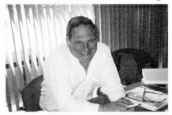
Roy Laubscher (Laubcorp. Santa Barbara) was the local host of this and three other meetings of the DDA. |
The 2000 Annual Meeting in YosemiteThe 31st annual meeting of the DDA was held 9-12 April 2000, in Yosemite National Park. Roy Laubscher (Laubcorp, Santa Barbara) was the local host. Roy did a fine job organizing the meeting, and the concessionaire was particularly effective and responsive in satisfying our needs.There were a total of 60 oral presentations (invited and contributed) and 13 poster presentations. This was the largest number of papers presented at any DDA meeting, which unfortunately necessitated reducing the time for each paper to 15 minutes from the customary 20 minutes. There were 83 registered participants. The meeting schedule and abstracts were printed in a handsome program with a picture of Yosemite Falls on the cover. Two or three posters were presented at each coffee break and all posters remained on display for the duration of the meeting. The weather was perfect throughout our stay in Yosemite, and some of us managed to sneak in a short hike or two through the magnificent scenery, and some stayed a day or two after the meeting to relax and enjoy. |
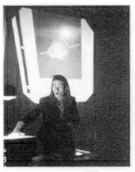
Invited speaker Robin Canup (SWRI) spoke on the various theories of the origin of the Moon.
|
Dedicated to the Memory of Bill KaulaWe were saddened to learn of the death of DDA founding member William M. Kaula only a week before the meeting began. We dedicated the meeting to Bill's memory with a tribute, which was read by DDA Chair, Stan Peale, at the opening of the meeting.Click here to see it. Origins SessionThe first meeting session, titled "Origins," began on Sunday afternoon with an invited paper, "Migrating Planets," by Norman Murray (CITA), which outlined various schemes to account for the close, giant planets around other stars. There followed a dozen papers dealing with various aspects of disk dynamics, planet formation and stability of other planetary systems.The next day began with an invited paper, "Origin of the Moon," by Robin Canup (SWRI). Robin pointed out the problems in the giant impact hypothesis of lunar origin and introduced a combination fluid-particle disk to study evolution after disk formation. Eleven papers of considerable variety followed in a session titled "Solar System Dynamics." These included papers on long term integrations of the solar system with comparison of numerical codes, evolution of asteroid orbits, asteroid noise in planetary motion, detection of a Europan ocean, and the Titan-Hyperion orbital resonance. The last paper was an invited review by Douglas Hamilton (U. Maryland), "Resonances, Drag Forces and the Jacobi Constant," where a variety of resonances and drag forces were shown to have a common mathematical development. |
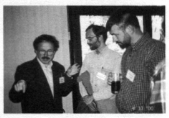
Invited speaker Andrea Milani (left, U Pisa) has the full attention of another invited speaker, Kim Griest (middle, UCSD), and Steve Chesley (JPL). |
Collisions SessionThe "Collisions" session began in the afternoon with an invited paper by Andrea Milani (U. Pisa), "Asteroid Hazard: Algorithms for Computation of Actual Cases," detailing a project for assessing the probability of impact on the Earth from known Earth-crossing asteroids. Several papers followed related to the current impact hazard and one paper on the effect of impact on planetary obliquities in the final stages of accretion. The last session on Monday, titled "Rings," dealt mostly with the details of Saturn's ring system, including the first radar images, brightness asymmetries, and formation. |
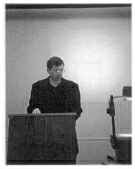
In the Brouwer awardee's absence, David Merritt (Rutgers U) delivered a clean and concise rendition of Antonov's Brouwer Lecture on his work on star motions. |
1999 Brouwer to AntonovThe 1999 Brouwer Award was given to Vadim Antonov of the Pulkovo Observatory in Saint Petersburg, Russia, but unfortunately, Antonov could not attend to receive his award in person. The matter was complicated by the fact that we were forced to communicate with Antonov through his colleagues Leonid Ossipkov and Victor Abalakin. Without the help of these kind men, there would have been no Brouwer Lecture. However, Antonov wrote his lecture, his colleague Alexander Baranov formatted it into LaTeX, and it was transmitted by Ossipkov to David Merritt, who presented Antonov's Brouwer Lecture, "Individual and Statistical Aspects of Star Motions." David's presentation was clear and concise, and his added comments on Antonov's work made us all appreciate why Antonov very much deserved the Award. |
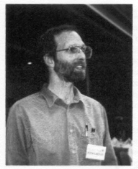
Kim Griest (UCSD) was invited to speak on gravitational lensing. |
Galactic DynamicsThe session "Galactic Dynamics" occupied the remainder of the morning. Orbital structure of eccentric nuclear disks modeled the double brightness peak in M3 1, and galaxy-galaxy interactions were treated. We also learned how fission of a cooling, rotating protostar might lead to observed close binaries with a striking animated display. The session ended with an invited paper by Kim Griest (UCSD), "Microlensing as a Probe of Galactic Dark Matter and Extra-solar Planets." No planets have been found, but it seems clear that compact baryonic objects in the galactic halo cannot be the dark matter causing the galactic rotation curve.Astrometry and BinariesThe afternoon session was titled "Astrometry and Binaries," and it included papers detailing the capabilities of interferometric astrometry using the Hubble Space Telescope (HST), the Palomar Testbed Interferometer (PTI), the Space Interferometry Mission (SIM), and HIPPARCOS. Two new catalogs from the USNO were described. From a paper not matching the session title, we learned of the search for stars passing close to the Sun that can perturb comets into the inner solar system. |
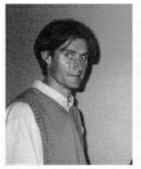
"The End of the Universe" was Greg Laughlin's (NASA Ames) rousing-good banquet lecture. |
Business Meeting and BanquetThe business meeting completed the afternoon, and after a brief period of free time we had our banquet. We were entertained after dinner by a lively talk by Greg Laughlin (NASA Ames), "The End of the Universe." |
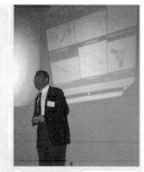
A progress report on Gravity Probe B in an invited paper by Sasha Buchman (Stanford U) kicked off the session on Relativity. |
Relativity and Spacecraft OrbitsTwo short sessions occupied the morning of the last day. In "Spacecraft Orbits," we learned of the complicated orbit of the NEAR spacecraft around the peanut-shaped asteroid Eros and perturbations during and observations of hyperbolic flybys of planets and satellites. The "Relativity" session began with an invited paper by Sasha Buchman (Stanford), on "Gravity Probe B." Gravity Probe B is designed to test Einstein's general theory of relativity by measuring the precession of free gyroscopes in Earth orbit due to the presence of the Earth's field. We were told that after all the technical problems have been solved and all parts fabricated, the nearly finished probe was broken and all tests have to be redone after repair. Other papers dealt with a new test of the equivalence principle and the relativistic perihelion precessions of all the terrestrial planets. |
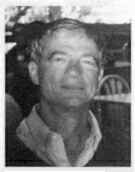
For his leadership in the development of JPL planetary ephemerides, Myles Standish has been named 2000 Brouwer Prize winner. |
The 2000 Brouwer to Myles StandishCelestial mechanics was the first quantitative physical science and remains one of the most successful and accurate. E. Myles Standish has led the development of the JPL planetary ephemerides, requiring in-depth knowledge of reference frames, astrometry, celestial mechanics, numerical integration techniques, estimation theory, error analysis, and data reduction. He has pioneered the use of unique data sets to improve the accuracy of the ephemerides. The JPL ephemerides provide international standards for spacecraft navigation, almanacs, historical astronomy, solar system tests of gravity theories, pulsar timing, and quantitative studies of long-term solar system dynamics. Standish and his colleagues have used these extraordinarily careful and accurate ephemerides to measure the masses of minor planets, to demonstrate that there is no dynamical evidence for Planet X, and to tie together the solar system and extragalactic reference frames with unprecedented accuracy. His classical escape criterion for the three-body problem has been incorporated in N-body codes for decades. His remarkable work has been of great service to the astronomical community, especially NASA’s program of solar system exploration. His ephemerides embody the finest craftsmanship of our discipline, and in a very real sense are the crown jewel of celestial mechanics. |
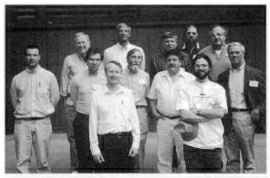
New, continuing, and retiring members of the Committee. Front row (fr. 1. to r) Steve Unwin, Marc Murison; Middle row: Joe Hahn, Kirk Borne, Bill Jefferys, Paul Weissman, Stan Peale: Rear row: Joe Burns, Myles Standish, Pete Shelus, Hal Levison, Bill Newman. |
Officers and MembershipThe officers elected for 2000-2001, Committee members elected for 2000-2002, and continuing Committee members are:
|
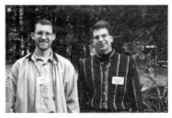
Graduate students Robert Salow (left, Ohio U) and Joseph D. Adams (U. Mass) gave papers as Student Stipend awardees. |
Student Stipend ProgamFor the sixth year, two student stipends were awarded at the annual DDA meeting. The recipients were Robert M. Salow from Ohio University, who spoke on "Self-Consistent Models of Eccentric Nuclear Disks," and Joseph D. Adams from the University of Massachusetts, who spoke on "Results on the Structure and Mass of the Pleiades from a 2MASS-USNO Proper Motion Search."To increase student participation, the Division makes available up to two student stipends of $400 each to attend Division meetings. For the April 2001 meeting at LPI in Houston, submit an abstract of a paper for presentation, along with a letter of recommendation from an adviser, to Dr. Gene Byrd, University of Alabama, Dept. of Physics & Astronomy, Box 35487-0324, Tuscaloosa, AL 35487-0324, or email, byrd@possum.astr.ua.edu. |
Call for Brouwer Award NominationsThe Brouwer Award Selection Committee of the DDA invites nominations from any member of the AAS for an award competition. The Brouwer Award has been established to recognize outstanding contributions to the field of dynamical astronomy, including celestial mechanics, astrometry, stellar systems, galactic and extragalactic dynamics. It is open to candidates of any age or nationality, occupation, or specific field of interest. The Award consists of an honorarium of $2000 plus an appropriate certificate.Letters of nomination should cite the achievements in or contributions to dynamical astronomy that might appropriately be recognized by the Award. Nominations should be supported by copies of the vitae and bibliography of the nominee and by letters of recommendation from three knowledgeable people testifying to the long-term impact of the nominee’s contributions to dynamical astronomy. Nominations and supporting documentation must be received 31 December 2000 by the Committee Chair, Dr. Douglas 0. Richstone, Univ. of Michigan, Dept. of Astronomy, Dennison Bldg., Ann Arbor, MI 48 109-1090, dor@astro.Isa.umich.edu. Additional information regarding the Brouwer Award may also be found at the DDA web site, http://dda.harvard.edu . Future DDA MeetingsThe next DDA meeting will be held at the Lunar and Planetary Institute (LPI) in Houston, Texas, during the latter part of April 2001. The local host will be Joe Hahn of LPI, and the program committee will consist of Joe Hahn, Hal Levison (Vice Chair), and Marc Murison (Secretary).The Timberline Lodge outside of Portland, Oregon, has been selected as the 2002 meeting site with Al Harris (JPL) as the local host. |